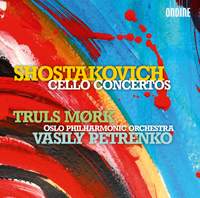Recording of the Week,
Shostakovich Cello Concertos from Truls Mørk
Vasily Petrenko – probably best known for his series of Shostakovich symphonies, now just one disc away from fruition – was recently appointed artistic director of the Oslo Philharmonic. He brings his extensive experience of Shostakovich to this first disc with them, offering powerful renditions of the two Cello Concertos with Truls Mørk as the soloist.

In the first, we hear Shostakovich in full-on sardonic mode. Although there are lyrical episodes, it’s not the expressive soliloquy one might expect of a cello concerto but an altogether edgier affair, never quite at ease with itself. Both the first and last movements are marked by Shostakovich’s characteristic use of shrill woodwind, providing an acerbic counterbalance to the rich voice of the cello. These interjections are dispatched with almost morbid glee by the wind players of the Oslo Philharmonic – calling to mind Berlioz’s grotesque witches’ sabbath. The ensemble is taut, and the solo passages (clarinet and horn making early appearances) fearless and extrovert.
Much of this movement sees the soloist ascend into the higher, more strained registers of the instrument – ably handled by Mørk, but agitated nonetheless – and Petrenko further cranks up the tension by using the staccato semiquavers that permeate the music to drive the tempo on relentlessly. There’s little sense of relaxation until the lament-like second movement. Here, warm woodwind chords provide an oasis of calm, and the movement’s quiet close, with the ethereal celesta and the cello’s eerie harmonics, is a moment of special beauty.
Unusually, Shostakovich treats the cadenza as an independent movement – Mørk’s introspective musings, accompanied by occasional pizzicato chords from the strings, gradually rise to a peak of intensity, heralding the orchestra’s return for the fourth movement, which echoes the upper woodwind-dominated sound of the first but also features some frenetic semiquaver passagework from the soloist.
The second concerto is less well-known but, for me at least, the more appealing work. Written in the Crimea in 1966, it was premiered at the composer’s 60th birthday concert later that year. The opening Largo sets an utterly different tone from that of the first concerto; ruminative and almost elegiac, with delicate arpeggios in the harp and more than a hint of the 5th Symphony’s exquisitely bittersweet slow movement.
One of the most striking elements of the second concerto is the way Shostakovich makes an unmistakably political statement in the first movement. After a slow-burning opening in which Mørk’s expressive playing can at last come into its own, the music builds to a climax which is suddenly and savagely beaten into submission by the bass drum. It’s a genuinely chilling, disorientating moment in which the bottom suddenly drops out of the music, and Petrenko’s treatment of it is unflinching. The sleeve notes describe this as “a graphic gesture that was not lost on early audiences” – and it’s one that is not without resonance today.
A technique common to both concerti is the “collage” effect of juxtaposing various musical ideas – an interruptive form of motivic interaction that creates a combative feel. Where in earlier concertos such as Dvorak’s or Elgar’s, the soloist is essentially on the same side as the orchestra, for Shostakovich the relationship is one of resistance, with soloist frequently pitted against ensemble. Mørk gives a good account of himself – though Shostakovich evidently wants it to sound like hard work. Given the well-known artistic and political struggles of both the composer himself and Mstislav Rostropovich (his friend and fellow artist, to whom both works were dedicated), it’s not hard to see where this ethos sprang from.
Emotionally, these aren’t easy works to listen to, but Truls Mørk presents them with passion and conviction and it is hard not to be quickly drawn in. Vasily Petrenko finely judges the Oslo Philhamonic’s responses – both the undulating supporting material and the brutal assaults that cut through the music to such dramatic effect. The woodwind and percussion sections are particularly on show here, and both acquit themselves brilliantly.
Samples can be found below – enjoy!
Truls Mørk (cello), Oslo Philharmonic Orchestra, Vasily Petrenko
Available Formats: CD, MP3, FLAC, Hi-Res FLAC



